10 Things You Can Do to Help the Homeless

Persons with no fixed address live in what some refer to as an “invisible world”. With your help, they may not be stuck there. Making their day-to-day lives a bit easier is helpful and important. There ARE things you can do.
This list of ten things to do may seem a little bizarre to you. But, a List of Shelters is very different from a List of Food Pantries or Soup Kitchens.
If you take this list seriously and use some of the suggestions, you’ll understand.
You’ll see.
But, whether you try to do one item or all ten, I send you gratitude. The things you do will ripple kindness out beyond your circle. And, right now, kindness is needed desperately.
DEVELOP A LIST OF SHELTERS
Search out local shelters and create a list card. List each shelter by location and include phone numbers and a bit of information which may be helpful to those without addresses.
Distribute copies of this card to homeless people.
MAKE A LIST OF FOOD PANTRIES
A homeless-friendly food pantry distributes ready-to-eat items like peanut butter and crackers in individual packets, cereal and milk in individual containers. Some food pantries offer small containers of fresh fruits and vegetables.
Search out area food pantries that are homeless friendly. Make an info card listing hours and days each pantry is open. Include the phone number, address and directions to get there.
Distribute copies of this card.
INCLUDE A LIST OF SOUP KITCHENS
Search out area soup kitchens. Make an info card listing hours and days each soup kitchen is open. Include the phone number and address with directions to find it.
Carry copies of this card to distribute.
DONATE CLOTHING
Organizations serving the homeless always need gently used items in good condition. They need items in all sizes from infant to XXL and beyond.
Blankets and sleeping bags are in demand year round.
People are always asking for socks.
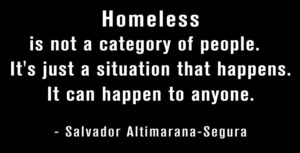
DONATE GROCERIES
Because the homeless carry their kitchens in their pockets, their food needs are specific: peanut butter and crackers in individual containers, individual packets of vegetables and fruits to be eaten raw (such as strawberries or carrots), cereal packed in individual containers, milk packed in individual containers.
When someone in your community conducts a food drive, donate a bag full of homeless-friendly foods.
If no one is having a food drive, fill a grocery bag with food and take it to your local food pantry, shelter, or soup kitchen.
Better yet, hold a food drive yourself.
In the past I’ve blogged posts about holding a food drive. Several dates of these posts include May 3, 2018, January 13, 2021 – February 11, 2021 – February 25, 2021. There are others.
Food drives are not difficult and they can be fun. Everyone should have the experience. Email me if you have questions. thurmangreo@gmail.com
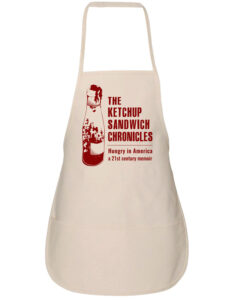
VOLUNTEER AT A SHELTER
Shelters depend on volunteers to sign people in, and cook and serve meals. Depending on the resources of the shelter, you may be able to do other things such as helping kids with homework, teaching ESL classes, writing resumes.
VOLUNTEER AT A SOUP KITCHEN
Soup kitchen volunteers pick up donations of food, help prepare and serve meals, cleaning up at the end of the shift.
VOLUNTEER AT A FOOD PANTRY
Volunteering at a food pantry is a community experience. I did it for years. Never, at any moment, did I feel I was wasting my time.
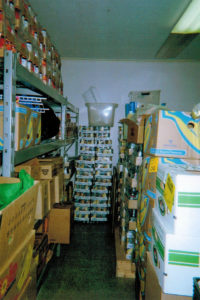
SHARE A MEAL
Whenever you leave your home, bring a bagged meal to share with a person on the street.
ADVOCATE
When you do a few of the things on this short list, you will find yourself involved in your community, even if that was not your intention.
Your interest in hunger and homelessness automatically makes you an advocate – even if you don’t think you are. When you help feed hungry and homeless people, you are fighting hunger in our country.
Most people in food pantries distribute a 3-day supply of food to everyone in each household.
But, however you see yourself, your good work, kindness, and generosity will ripple out beyond yourself and your community.
One thing is for sure, we need more good work, kindness, and generosity rippling out.
Something else happens when you share info cards, bagged lunches, food, and sleeping bags:
The homeless people you interact with begin to lose their invisibility. You replace that invisibility with respect when you treat them as individuals. Courtesy, kind words and a smile will change not only your life but theirs. .
You may even learn someone’s name!

Thank you for reading this blog post. Please share it with your favorite social media network.
Forward it to a friend or relative.
Learn more about hunger and homelessness on YOUTUBE at “Let’s Live with Thurman Greco”.

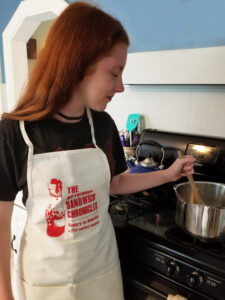
 Hats, aprons, T-shirts, and books are available at www.thurmangreco.com
Hats, aprons, T-shirts, and books are available at www.thurmangreco.com
Having touble finding YOUTUBE interviews? Send an email to thurmangreco@gmail.com. We’ll get you there!

Thanks!
Thurman Greco
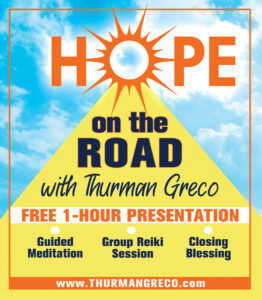
One last commercial here: A “HOPE on the ROAD” presentation was recorded and is on YOUTUBE. Tune in to YOUTUBE to benefit from this presentation.
I can present a segment of “HOPE on the ROAD” to your library, your organization, your class, your group.
If you are a Reiki practitioner, “HOPE on the ROAD” is easy to learn so you can present it to people in your area.
There is no charge for “HOPE on the ROAD”. To participate in “HOPE on the ROAD”, contact me at thurmangreco@gmail.com.
Thanks again,
Thurman
Miracles – Because Hunger is Not a Disease

Miracles happened in the food pantry. It took me a while to realize this and then it took another while to accept that such a thing could happen in the basement of a small town church in Upstate New York.
I sneaked miracle stories in on the blog posts. I sneaked them on the pages of “I Don’t Hang Out in Churches Anymore”. Finally, I gave them their own pages – as much as I had the nerve for anyway, in a short book “Miracles”.
Research on miracles taught me some things.
I learned that miracles often include weeping statues, broken legs healing straight, relics, stigmata, and visions. The pantry miracles included none of those things.
Our miracles never really cured anyone. I never saw a statue weep, and no one came down with stigmata.
Instead, they showed us all how to grow and love and forgive. It was giving away the food that was the tip off for me.
As far as I can tell, the food pantry miracles were not the result of prayer.
God just showed up and brought food. Once he came disguised as a fireman. Each miracle was a complete surprise, a unique and different event. God came when the pantry shelves were bare and the lines were long.
I don’t think the miracles proved that any of the shoppers or volunteers were more faithful than anybody else in town. Frankly, I think that some of us saw the miracles as coincidences or something.
However they were seen, these events made an impact on a small number of people who saw them as they happened.
The clincher for me occurred when I finally realized and accepted a few basic things:
Carloads of food never showed up when we didn’t need it.
Boots never appeared on the shelves disguised as toothpaste in the summertime.
Nobody ever brought a handful of nails to fix the barn when the wall wasn’t falling.
Two books appeared on my desk out of the ethers: “Miracles” by Tim Stafford and “Looking for a Miracle” by Joe Nickell gave a feeling of legitimacy to my thoughts and memories.
Because of Tim Stafford, I wrote my book entitled “Miracles”. He was direct about a few things – one of them being that people should not spread “miracle gossip”. Because of his feelings about what he called “miracle gossip”, I’m compelled to relate the pantry miracle stories.
To sneak them in blog posts does not do them justice.
Thank you for reading this blog post. Please refer it to your favorite social media network.


Thurman Greco




